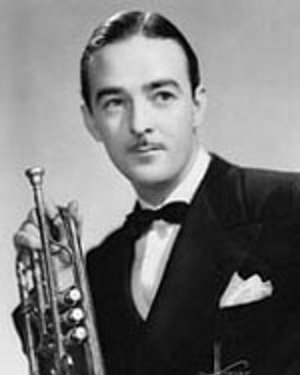Bobby Hackett

-
Birth Name
Robert Leo Hackett -
Born
January 31, 1915
Providence, Rhode Island -
Died
June 7, 1976 (age 61)
Chatham, Massachusetts -
Featured Vocalists
Nita Bradley
Linda Keene
Louise Tobin
Though jazz cornetist Bobby Hackett was also proficient on the guitar, it was his horn work that brought him prominence. His mellow tone and melodic style contrasted sharply with the brash sound of many of his early contemporaries, especially when he played Dixieland. A sought-after instrumentalist, Hackett worked with dozens of top artists during his long career and briefly led his own big band.
Hackett began working professionally in an around the Boston area soon after graduating high school. Appearing with such artists as Teddy Roy, Pee Wee Russell, Herbie Marsh, Payson Re, and the Harvard Gold Coast Orchestra, he quickly earned a reputation. In 1936, he was asked to form a Dixieland outfit for Boston’s Theatrical Club. The group proved very popular, and after their one-year engagement ended the members decided to try their luck in New York. Unable to get a job as a group, they eventually split up, and for the next couple of years Hackett worked on and off with small outfits of his own and with other artists, including Benny Goodman, Teddy Wilson, Jack Teagarden, and Eddie Condon. He recorded on the Vocalion label in February and November 1938, with Linda Keene singing on one side in November.
Bandleader and Miller Years
In April 1939, Hackett formed his own big band. Louise Tobin, then the wife of Harry James, was featured vocalist. She left mid-year to join Goodman’s orchestra. Claire Martin sang in July. The group contracted with MCA and made several recordings on Vocalion, but financial problems forced it to disband in September, after only six months. Owing MCA almost $3000, Hackett decided to take a steady job with Horace Heidt in order to pay off the band’s debts. In early 1940, Heidt allowed Hackett to record under his own name on Vocalion, with the additional credit “Horace Heidt Presents.” He remained with Heidt through the summer season of 1940, leaving to briefly form a new combo which took up residence at Nick’s jazz club in New York. The combo eventually expanded into a band by adding a three-man reed section. Nita Bradley sang. In spring 1941, he took over the house band at Boston’s Versailles.
Later in 1941, Hackett joined Glenn Miller. Miller and Hackett were close friends, and Miller helped renegotiate Hackett’s debt. Hackett also recently had had dental surgery and was unable to play the cornet, so Miller placed him as a guitarist. Hackett eventually took up his horn again and can be heard as the featured soloist on the Miller standard “String of Pearls.”
When Miller disbanded his orchestra in 1942 to join the Army Air Force, Hackett took a studio job at NBC. He also spent a brief time with Katherine Dunham’s revue. In 1943, he joined the Casa Loma Orchestra and remained with them for two years. He then took a job with ABC, where he spent the next fifteen years. In December 1943, he recorded two sides for Brunswick. He recorded two sides on the Melrose label in 1945 and two for Commodore in 1948.
From the 1950s up until his death from a heart attack in 1976, Hackett continued performing and recording. He led several small groups and worked closely with many other top artists, including Goodman, Teagarden, Tony Bennett, Billie Holiday, Louis Armstrong, Frank Sinatra, Maxine Sullivan, and Lee Wiley. In the early 1950s, Hackett was the star of Jackie Gleason’s memorable “Music for Lovers Only” album series.
Sources
- Simon, George T. The Big Bands. 4th ed. New York: Schirmer, 1981.
- “Hackett Leaves Nick's to Tour.” Down Beat Apr. 1939: 3.
- “Orchestra Notes.” Down Beat 30 Sep. 1939: 10.
- “Bobby Hackett Leaves Heidt.” Down Beat 15 Apr. 1940: 1.
- “New Men With Bobby Hackett.” Down Beat 1 Oct. 1940: 23.
- Frazier, George. “Bernie Billings' Tenor a Colossal Thrill.” Down Beat 15 Apr. 1941: 12.